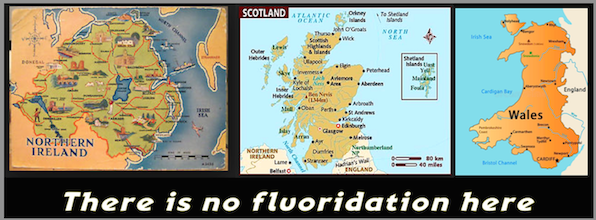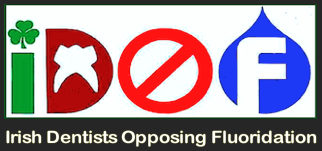You are here: Home1 / When Gerry Adams And Ian Paisley Worked Together
…The result was that, in 1995, a stunning 25 out of 26 local
councils in Northern Ireland voted against water fluoridation.
So also did the four Area Health and Social Services Councils.
It was an unprecedented show of democratic strength…



Politics/Frontlines: 20 Jun 2013
Updated 04 Nov 2013
Adrienne Murphy ←
When Gerry Adams And Ian Paisley Worked Together !


It was long before the Belfast Agreement. But the campaign against fluoridation in Northern Ireland united these political foes in a campaign that defeated the British Government’s plans to fluoridate the North.
So why was this extraordinary rapport ignored in the South? asks campaign leader Walter Graham.
People who have been following the ‘Hot Press’ investigation into the mandatory fluoridation of the water supply in Ireland will be aware that the Irish Republic is the only country in Europe dosing its citizens with hydrofluorosilicic acid on what is effectively a universal basis. The only other European citizens receiving fluoride through their taps are 10 per cent each of the British and Spanish populations.
While the authorities here claim that the levels of fluoride in the water are ‘safe’, what we are talking about is a highly toxic chemical, with many known adverse health-effects. The extent of these adverse effects does indeed depend on the amount of fluoride consumed: enough of it would kill you stone dead. But there is serious disagreement within the scientific community worldwide as to what – if any – might constitute a ‘safe’ level of fluoridation.
Because, the inescapable truth is that no one can state for sure just how much fluoride any individual in Ireland ingests at any time. There is fluoride in foodstuffs. There is fluoride in most brands of toothpaste. And we all consume different amounts of tap water – not just through what we drink directly, but also in our soups, foods, cups of tea and coffee and so on, [ bath water – skin absorption ].
Meanwhile, there are individuals who are exceptionally sensitive to fluoride’s harmful effects, whether because of age, lifestyle or a wide range of other health factors. As an example, people with diabetes and low renal clearance will almost certainly be more susceptible to fluoride toxicity. Similarly, a huge amount of fluoride, in relation to body-weight, is consumed by newborn babies that are fed formula milk made with fluoridated tap water (a practice that has been warned against by numerous organisations internationally, including the US Centre for Disease Control and the American Dental Association).
Considering the uncontrolled way in which the entire population is ingesting fluoride, how can anyone credibly talk about safe levels? It is a question that is not going to go away, no matter how often the authorities offer bland reassurances.
How many Irish citizens know that the Republic is fluoridated while the North is not? Well, here is another fact: on the island of Ireland, the South has cancer rates that are considerably higher than Northern Ireland. The South also has one of the highest cancer rates in Europe, if not the highest. Might these facts be inextricably interconnected?
More facts: unlike citizens of the Republic, our fellow islanders across the border had the opportunity to vote down fluoridation, rather than having it imposed on them by law as in the south. And they did precisely that, resoundingly rejecting the threat of fluoridation at local council level.
This was a huge victory, won despite the fact that there was massive pressure coming from the UK government to initiate fluoridation. You might have assumed that the outcome would have been widely reported in the media in the Republic. After all, the campaign against fluoridation involved what was at the time a completely unprecedented cross-community, cross-party co-operation between Unionists and Nationalists.
And yet, the issue was all but ignored by the national newspapers and by RTE. It is an extraordinary omission, which perplexed campaigners at the time. Indeed it still does…
Walter Graham was one of the main protagonists in the battle to keep Northern Ireland fluoride-free. Graham, originally from the US and self-employed in the marketing of pharmaceuticals at the time, has been living in NI for over twenty years. He is eager to tell the extraordinary story of how people resisted the threat of fluoride. And also to explore the strange silence of the Irish media on what was a remarkable saga by any standards.
“The British government announced in 1995 that they were going to fluoridate Northern Ireland,” he recalls. “That’s what got me started on this campaign. I sent letters to the papers saying this was crazy. A basic law of pharmacology is that every drug has side-effects. Yet here they were saying that fluoride, a potent poison, could be drip-fed it into everybody’s water for a lifetime and there’d be no side-effects. It’s an impossibility.
“I questioned how they were going to control the dose in the water system,” he adds. “Just because you’re putting it in at a dosing point doesn’t mean that it stays at exactly a concentration of 1ppm suspended – or whatever – until it gets to your house. And then once you put it into the water, you put it into everything – so that now it’s in all food and drink.”
Graham recollects the logic of his thinking at the time.
“So it’s out of control, guaranteed. Plus it’s in dental products and pesticides. What does the F in the CFCs that cut the hole in the ozone stand for? Fluoride. So it’s raining down on us too. Coal burning and nuclear power plants create it. We’re getting a lot of this stuff. And certainly, if you add it to the water system, there’s going to be a lot of overdosing with it, and a lot of dental fluorosis. And, I believe, neurological damage.
“That’s the gist of what I wrote to the papers at the time. I also said that 98 per cent of Europe aren’t doing this. So they’d obviously found a better way of treating dental decay – because many European countries have better teeth than they do in the Republic of Ireland.”
In response to Graham’s letter, a local paper published a defence of water fluoridation, written by a dentist, which dismissed scientific studies on fluoride toxicity in much the same way as the Irish authorities dismiss them.
Alarmed, Graham and a small team of others who understood the dangers took it upon themselves to alert the councils of Northern Ireland, who had been given a period of three months in which to consider water fluoridation and to vote for or against.
Technically, the authorities could have ignored the vote – but clearly they wanted to create a fig leaf of local agreement. They hadn’t bargained for the persuasiveness of Graham and his fellow campaigners.
This voluntary team of fluoride whistleblowers went into action. They presented the facts about water fluoridation, as they understood them, to the 26 councils of Northern Ireland, alerting councillors to well-documented risks associated with fluoridation, from neurotoxic to cancer-related effects.
The result was that, in 1995, a stunning 25 out of 26 local councils in Northern Ireland voted against water fluoridation. So also did the four Area Health and Social Services Councils. It was an unprecedented show of democratic strength.
“At the time,” Graham recalls, “Malcolm Moss, who was the Health Minister, said in response, ‘We don’t care what the councils think – we’re going to do it anyway’. This upset the councillors, because what was the point in asking their opinion if you were just going to go ahead and do it anyway?”
What happened next was historical – and yet was largely ignored south of the border.
“In England,” Graham explains, “they had formed coalitions of councils to resist fluoridation, and it was suggested that we do the same. So I went to the councils and found a councillor from each party who had voted against it. Certain parties had voted against it en masse, like Sinn Fein, the DUP and the SDLP.”
Thus, Graham became the official PR and Information Officer of the Coalition of Councils in Northern Ireland Against Water Fluoridation. A committee of this coalition met every two weeks to strategise on how to keep fluoridation out of the North. Other groups were drafted in as support, including the Students’ Union at Queens University; both farmers’ unions (whose members feared ecological, crop and animal damage from the large quantities of fluoride that would end up in the environment through fluoridated waste water); a large civil servants’ union (whose members included the workers who would have had to handle fluoride); and the Angling Federation (concerned by the risk to fish-stocks).
A key player in this battle against the introduction of water fluoridation across Northern Ireland was Shorts, the aerospace giant, who threatened to pull out of NI if fluoridation went ahead.
“The reason Shorts was opposed was because fluoride bonds with metals,” explains Graham. “It will leech, say, aluminium out of airplane wings. And Shorts did all their welding under water. They couldn’t do their welding if fluoride was present. Therefore the company would have had to spend millions on a water treatment plant to get the fluoride out before they did their welding. Plus they’d be left with a highly toxic substance – fluoride – which they’d have to treat, and bury in a lined landfill somewhere. And they’d have to hire personnel to do all of this. It would have made them uncompetitive.
“What’s really extraordinary,” adds Graham, “is that in the middle of the Troubles – bombs going off, police being shot – the only thing that the DUP and Sinn Fein, Gerry Adams and Ian Paisley Snr, agreed on, was that fluoridation shouldn’t go ahead. How did that not make the news? It certainly didn’t make the news in the south. You didn’t even know we were having this whole struggle.”
As part of the NI anti-fluoridation campaign, informed citizens’ groups were established, and there were anti-fluoridation marches to Stormont.
“When the Eastern Health Board (NI) was going to make its decision about fluoridation,” continues Graham, “again, a small band of us handed in information to the people on that board showing the scientific concerns, and we staged a protest in front of the building. I was brought in to give a talk. They gave me three minutes. I pleaded with them to do the right thing – not to drug everybody against their will. In the end there were two doctors on the health board who had looked at the studies, and they were worried. They voted against. They needed a unanimous vote, and they didn’t get it, so the Eastern Health Board couldn’t support it.”
Graham remembers the rhetoric he used in presentations to the councils. “‘So you’re telling me,’ I’d say, ‘that the fluorine ion goes in and passes the teeth at a hundred miles an hour, and it’s water soluble and has access to every cell of your body, but magically it finds its way to teeth only, and drastically alters them. What mechanism does it use to differentiate between teeth and bone cells? It’s got access to every cell in your body, yet magically it only changes the teeth. How does it do that?’
“The fluoridationists were unable to answer that,” adds Graham. “Because logically, if fluoride can drastically alter the teeth by making them harder, or causing structural damage as in dental fluorosis, then it can also make harder bones, and it can damage bones. And there’s a large group of international studies proving that fluoride causes higher hip fracture rates in fluoridated areas compared to non-fluoridated areas. And osteoporosis is higher in fluoridated areas – in fact, the south of Ireland has a higher osteoporosis rate than NI.
“Governments pushing fluoride get caught in a Catch 22. They cannot admit even one side-effect, because that may lead to litigation. They are admitting that fluoridation is causing huge amounts of dental fluorosis [discoloured marks on the teeth, sometimes leading to an erosion or breaking away of the enamel], but they term it ‘cosmetic’. Dental fluorosis is actually real structural damage to the teeth. But admitting even one side-effect invokes the precautionary principle in medicine: if there’s even one study showing harm, you cannot go ahead with it.”
“You’re about to poison the whole population, and you can’t even explain how this stuff works?” Graham would say at meetings: “And you don’t have any proof that it doesn’t affect the bones and other tissue?”
“I also warned the councils that I thought it would eventually end up in litigation,” he recalls now. “You people here tonight will pass and approve something that you yourselves have no knowledge about being safe. And just like asbestos when it was proved to be wrong, who will be held accountable? It’ll be you. And for what? For dental decay? I don’t see that as being worth it.”
In 1998, after a hard-fought two-year campaign, the British government decided against proceeding with fluoridation in Northern Ireland. In the process, two communities in the – Holywood in Co. Down and Tandragee in Co. Armagh – that had been ‘experimentally’ dosed with fluoride in the 1970s, successfully lobbied to get the fluoride removed from their water.
“The fluoridationists were finished in the North – for the time being,” says Graham.
In 2006, the largest ever review of the world’s scientific literature on fluoride and health – known as the National Research Council (NRC) report – was published in the US. The NRC report highlights many serious health risks associated with water fluoridation. It was ignored in Ireland.
Walter Graham was troubled by the deafening silence with which the report was met here. Hoping to focus media attention in the South, Graham secured two letters, which voiced opposition to water fluoridation – one from Gerry Adams of Sinn Fein, and another signed by Ian Paisley Snr of the DUP and addressed to the Irish Human Rights Commission.
Why was no Irish national newspaper interested in a letter from Ian Paisley to the Irish Human Rights Commission? It seems bizarre but Graham did not succeed in getting any coverage in the mainstream media. Then, just 18 months ago, the Northern Ireland Minister for Health, Edwin Poots, announced a renewed intention to fluoridate the North, provoking a new flurry of public awareness-raising on the issue.
“There is still a push to fluoridate,” says Graham, “but the Health Minister is getting challenged in the form of questions being put in – making the point that you can’t control the dose, that babies are being overdosed, that it’s medically controversial around the world – which he’s now refusing to answer. There’s much more awareness of the dangers of fluoridation in the North than there is in the south – and we don’t even have it!
“It’s amazing,” Graham adds. “You guys have been drinking this for nearly 50 years, and there’s a lack of awareness that it’s even in the water. And your government is required by law to do side-effects studies – and they’ve never been done? You’re required by European law to do environmental studies, and they’ve never been done? It’s never been passed or approved by the medicines control board as a drug, and yet that’s what it is? They’re making medical claims that fluoride cuts down the rate of dental decay, and yet your government is still calling it ‘cosmetic’.
“It’s massive what your government is doing. They haven’t proved that any of the plethora of studies linking fluoride to adverse health effects are incorrect – instead, they just write them off. When the fluoridationists present their case, it’s a bluff. They are unable to name one scientific study showing this stuff has been tested for safety on humans. Hydrofluorosilicic acid has never been tested for safety, ever, and yet it’s being fed to millions of people.
“They’re required by the same law that they used to fluoridate, to do side-effect studies, and they’ve never done one. The government has the ideal opportunity to prove that there are no side-effects to water fluoridation: you’ve got a population sitting there drinking it for the last 50 years; you’ve got doctors in the Department of Health – do a study. Prove that fluoridation doesn’t cause all this damage that we’re worried about.
“It goes back to ‘Seek and ye shall find’. They know not to go looking. Because that’s what did the tobacco industry in. They started doing studies and they found that it caused cancer, and they buried the studies. It came out eventually and that’s what’s killing them in court – because they knew about the studies and they lied about it.”
The most disturbing part of Walter Graham’s water fluoridation presentation is the section on cancer. The Republic has considerably higher rates of cancer than Northern Ireland, and one of the highest cancer rates in Europe. When Graham shows his ‘cancer maps’ – based on the All-Ireland Cancer Atlas produced by the Irish government – he also cites the scientific evidence of Dr Dean Burk, a top employee of the US National Cancer Institute until the mid-1970s, and one of the 20th century’s most prominent cancer researchers.
“Burk conducted a study comparing the 10 largest fluoridated US cities with the 10 largest non-fluoridated cities,” says Graham. “They all had the same cancer rate until the year that fluoridation started. Then the cancer rate in the fluoridated cities started to go up. Burk concluded that water fluoridation causes an increase in all cancers. And that’s what you’re seeing in the South compared to the North.” (You Tube: ‘Dr Dean Burk – fluoride causes cancer’.)
Graham shows the Ireland cancer maps to every politician he can, North and South. And he notices a distinct difference in the reactions.
“When I show those cancer maps to politicians in the North, they all go, ‘Wow’. In the south, they often say, ‘How dare you show us those cancer maps. That difference could be caused by anything!’ Yet here’s Dean Burk saying fluoride causes an increase in all cancers – and in the South, you have an increase in cancers. Now I can’t swear that fluoride is causing the increase – but boy, we have to suspect that it’s true: you’ve got amongst the highest cancer rates in Europe.
“It’s a different kind of mindset when you haven’t had fluoride. Why would you want it? When politicians from the North look at it, they ask, where’s the benefit? 99.9% of the fluoride is lost in underground leaks, wasted water, and flushed. That’s a fact. And you’re talking about trying to prevent dental decay in a small group of kids from low-income families, who often don’t even drink the water supply – because they’re drinking fizzy drinks, which is why they have really bad teeth.
“Nothing about this makes sense. But somehow when those cancer maps come up, many of your politicians, their backs go up, and they say: how dare you show us stuff like this?
“The Irish government were the only ones who knew about those maps until the fluoride whistleblowing scientist, Declan Waugh, unearthed them. What do Irish State politicians think, when they see that the south is all in purple and the North is all in green, which denotes much lower cancer rates? If this isn’t sending up alarm bells, then something’s gone wrong. We’re the same people – we share the same land, the same oxygen, genetically we’re identical. Why is there such a difference? Why does it stop at the imaginary borderline? There is no real border. That’s just a marking on a map. But the water pipes stop at the border.
“No matter what the reason for the difference, the government in the south should be investigating it. Not denying that it’s fluoride, which is what they’re doing. If Dean Burk’s studies stood up in three Supreme Courts in America as proving that this stuff causes harm, who are we to say that it doesn’t? And now we’ve got these maps saying exactly the same as Dean Burk was saying.
“We should err on the side of safety. If there’s even one study saying that fluoridation causes cancer – and there are a lot of studies saying it – then we shouldn’t be doing it. But the studies saying it causes cancer are being ignored. There are studies saying it causes Downs Syndrome – they are being ignored. The studies saying it causes depression, thyroid dysfunction and osteoporosis – they’re being ignored too.”
Northern Ireland is just one amongst many communities who have rejected water fluoridation.
“In the Isle of Man, three or four years ago, they were facing the same pressure,” Graham reflects. “They’d been trying to fluoridate the Isle of Man for years. They had a public debate, and the politicians came out against it. When it’s put to people, they vote no.
“Since they did away with mandatory fluoridation in Queensland in Australia recently, and left it up to the councils to decide, 500,000 people are now fluoride-free for the first time. The councils took it out.
“When you’re given a choice, as in the rest of Europe, fluoridation doesn’t happen. The people in the South of Ireland were never given a choice. And you’re still not getting one.”
*For more information, visit hotpress.com and type fluoride into the search engine; check thegirlagainstfluoride.com; and fluoridealert.org
Frontlines: West Cork says no!
Clonakilty is aiming to become Ireland’s first fluoride-free town.
The Fluoride Debate: Open Letter to Irish Water
Campaigner Aisling FitzGibbon has written an open letter to Irish Water –
the new semi-State body that is taking charge of the management of the national water supply.
Adrienne Murphyinvestigates.
Fluoride: Interview with Thomas Sheridan
There are times when the official attitude to fluoride seems like a textbook case of psychopathology in action. So says author Thomas Sheridan, who has made a study of institutional psychopaths.
Fluoride Debate: Another Whitewash on the Way?
Though organisations such as Irish Dentists Opposing Fluoridation continue to highlight major concerns about the Irish water system, there are fears that a new government review will fail to tackle the real issues.


Scroll to top

